WS5103 Community Development: Case Study Analysis and Principles
VerifiedAdded on 2022/09/12
|12
|3223
|29
Report
AI Summary
This report delves into the multifaceted field of community development, exploring its core principles and practical applications through the analysis of two case studies. The introduction establishes community development as a practice-based career and academic discipline that supports sustainable growth and social justice. The report examines the historical context of community development, referencing key figures and organizations that have shaped the field. Two case studies are presented, one from Australia and the other from an international context, to illustrate different approaches to community development. The report then defines community development, highlighting the importance of local representation and participation. It also outlines key principles such as sustainability, broader participation, and self-dependency. Furthermore, the report addresses challenges faced in community development, including inadequate planning strategies and the need for a more comprehensive and inclusive approach. The document concludes by emphasizing the importance of community engagement, infrastructure, and a commitment to learning and change for successful community development.
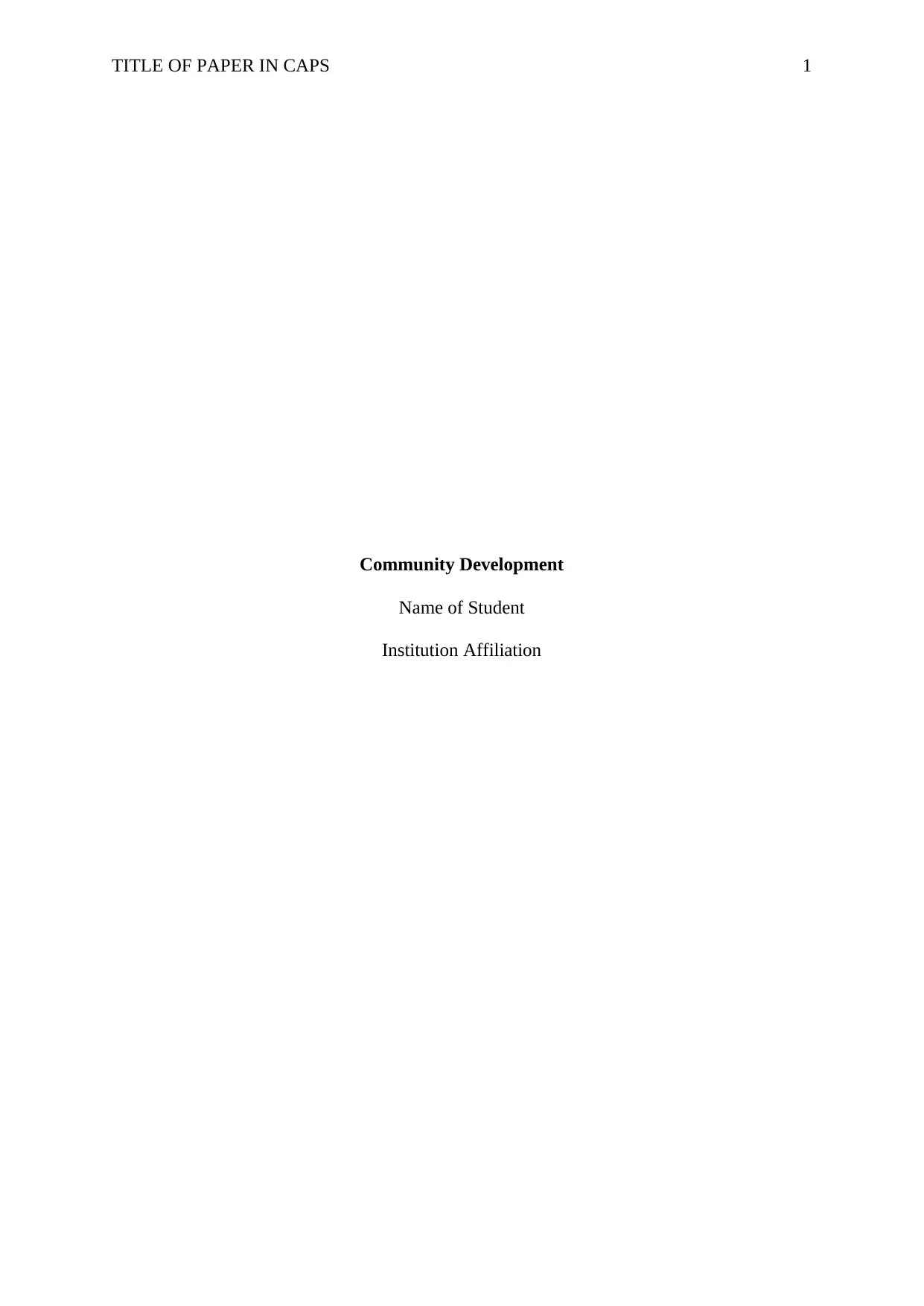
TITLE OF PAPER IN CAPS 1
Community Development
Name of Student
Institution Affiliation
Community Development
Name of Student
Institution Affiliation
Paraphrase This Document
Need a fresh take? Get an instant paraphrase of this document with our AI Paraphraser
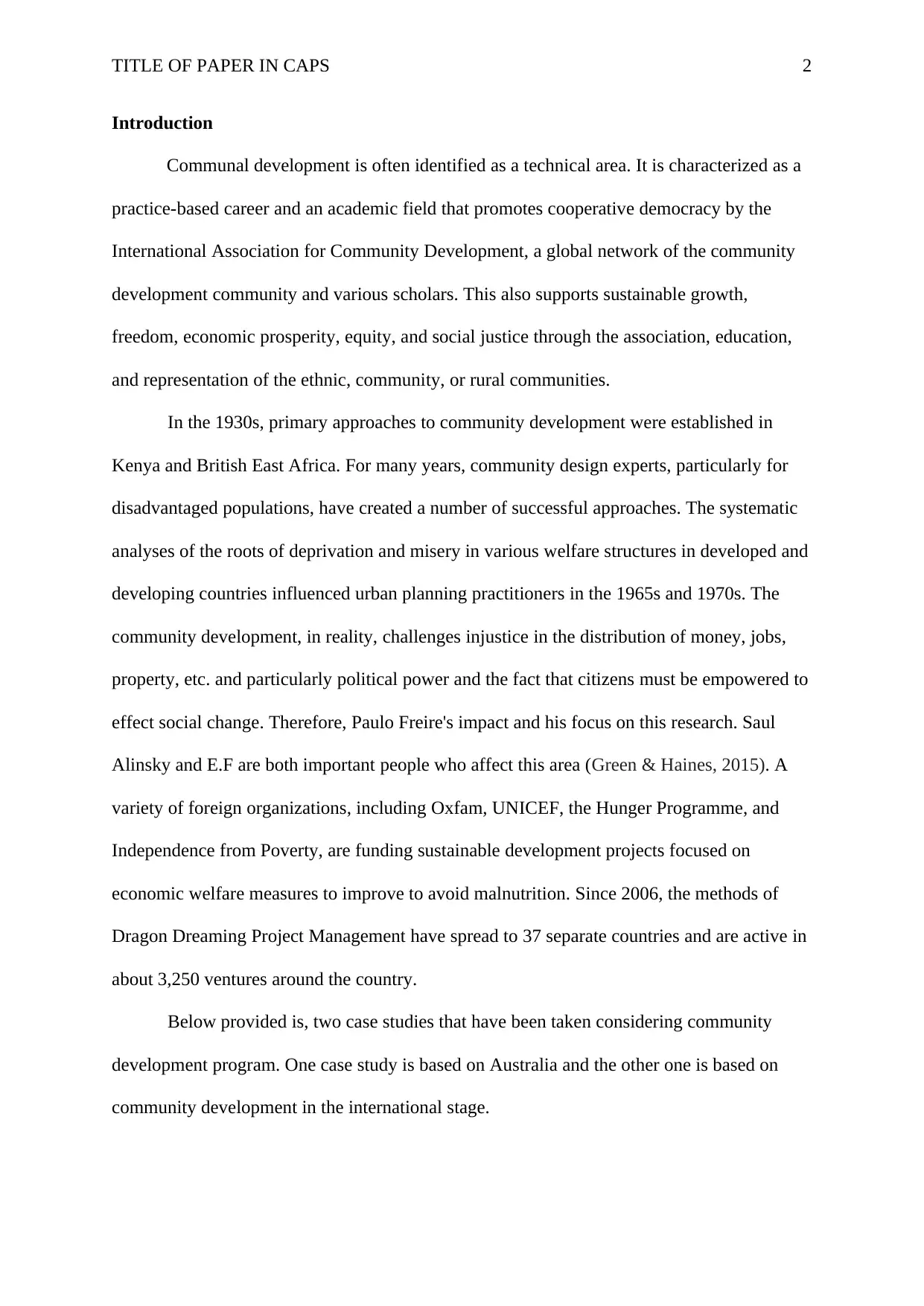
TITLE OF PAPER IN CAPS 2
Introduction
Communal development is often identified as a technical area. It is characterized as a
practice-based career and an academic field that promotes cooperative democracy by the
International Association for Community Development, a global network of the community
development community and various scholars. This also supports sustainable growth,
freedom, economic prosperity, equity, and social justice through the association, education,
and representation of the ethnic, community, or rural communities.
In the 1930s, primary approaches to community development were established in
Kenya and British East Africa. For many years, community design experts, particularly for
disadvantaged populations, have created a number of successful approaches. The systematic
analyses of the roots of deprivation and misery in various welfare structures in developed and
developing countries influenced urban planning practitioners in the 1965s and 1970s. The
community development, in reality, challenges injustice in the distribution of money, jobs,
property, etc. and particularly political power and the fact that citizens must be empowered to
effect social change. Therefore, Paulo Freire's impact and his focus on this research. Saul
Alinsky and E.F are both important people who affect this area (Green & Haines, 2015). A
variety of foreign organizations, including Oxfam, UNICEF, the Hunger Programme, and
Independence from Poverty, are funding sustainable development projects focused on
economic welfare measures to improve to avoid malnutrition. Since 2006, the methods of
Dragon Dreaming Project Management have spread to 37 separate countries and are active in
about 3,250 ventures around the country.
Below provided is, two case studies that have been taken considering community
development program. One case study is based on Australia and the other one is based on
community development in the international stage.
Introduction
Communal development is often identified as a technical area. It is characterized as a
practice-based career and an academic field that promotes cooperative democracy by the
International Association for Community Development, a global network of the community
development community and various scholars. This also supports sustainable growth,
freedom, economic prosperity, equity, and social justice through the association, education,
and representation of the ethnic, community, or rural communities.
In the 1930s, primary approaches to community development were established in
Kenya and British East Africa. For many years, community design experts, particularly for
disadvantaged populations, have created a number of successful approaches. The systematic
analyses of the roots of deprivation and misery in various welfare structures in developed and
developing countries influenced urban planning practitioners in the 1965s and 1970s. The
community development, in reality, challenges injustice in the distribution of money, jobs,
property, etc. and particularly political power and the fact that citizens must be empowered to
effect social change. Therefore, Paulo Freire's impact and his focus on this research. Saul
Alinsky and E.F are both important people who affect this area (Green & Haines, 2015). A
variety of foreign organizations, including Oxfam, UNICEF, the Hunger Programme, and
Independence from Poverty, are funding sustainable development projects focused on
economic welfare measures to improve to avoid malnutrition. Since 2006, the methods of
Dragon Dreaming Project Management have spread to 37 separate countries and are active in
about 3,250 ventures around the country.
Below provided is, two case studies that have been taken considering community
development program. One case study is based on Australia and the other one is based on
community development in the international stage.
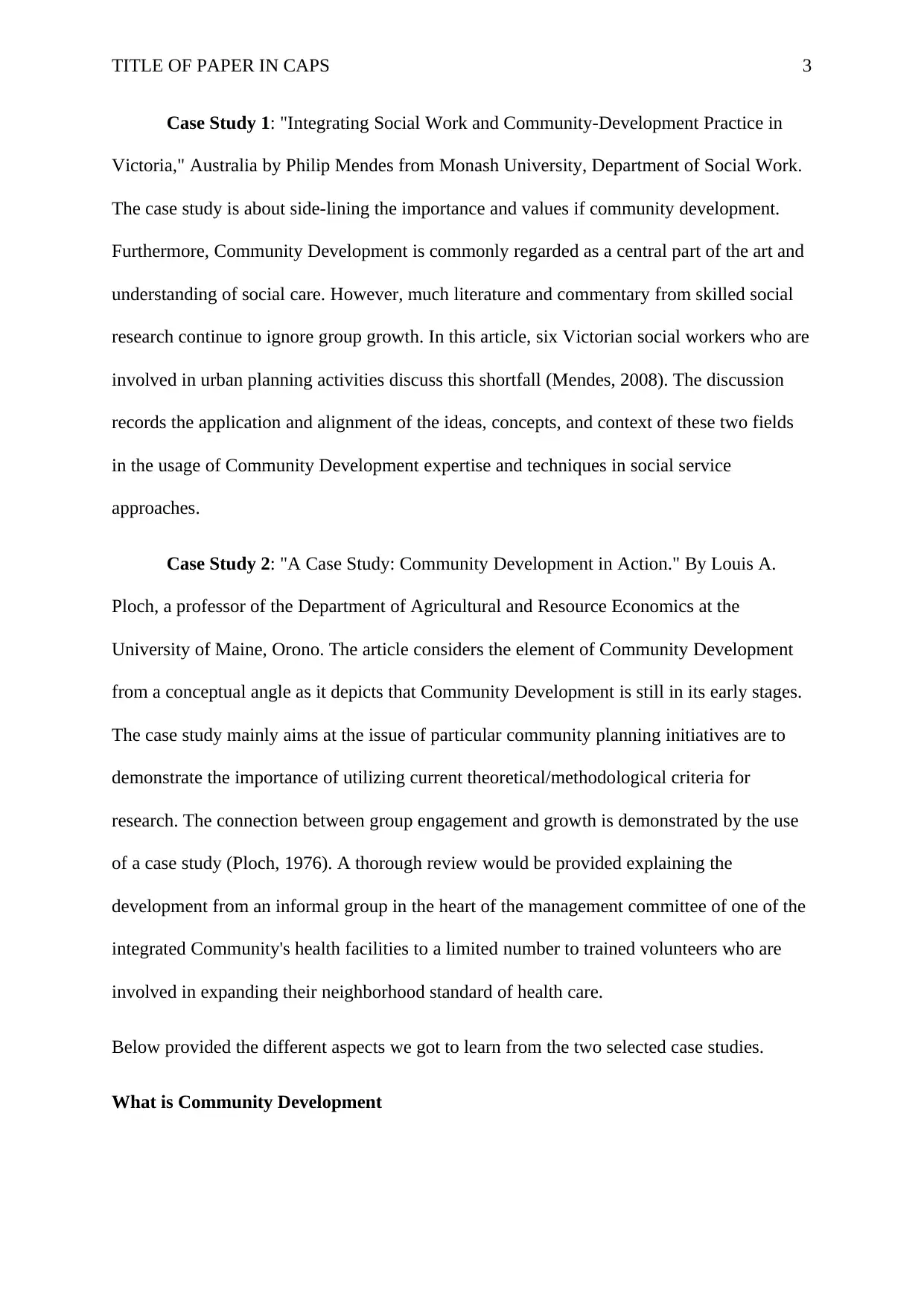
TITLE OF PAPER IN CAPS 3
Case Study 1: "Integrating Social Work and Community-Development Practice in
Victoria," Australia by Philip Mendes from Monash University, Department of Social Work.
The case study is about side-lining the importance and values if community development.
Furthermore, Community Development is commonly regarded as a central part of the art and
understanding of social care. However, much literature and commentary from skilled social
research continue to ignore group growth. In this article, six Victorian social workers who are
involved in urban planning activities discuss this shortfall (Mendes, 2008). The discussion
records the application and alignment of the ideas, concepts, and context of these two fields
in the usage of Community Development expertise and techniques in social service
approaches.
Case Study 2: "A Case Study: Community Development in Action." By Louis A.
Ploch, a professor of the Department of Agricultural and Resource Economics at the
University of Maine, Orono. The article considers the element of Community Development
from a conceptual angle as it depicts that Community Development is still in its early stages.
The case study mainly aims at the issue of particular community planning initiatives are to
demonstrate the importance of utilizing current theoretical/methodological criteria for
research. The connection between group engagement and growth is demonstrated by the use
of a case study (Ploch, 1976). A thorough review would be provided explaining the
development from an informal group in the heart of the management committee of one of the
integrated Community's health facilities to a limited number to trained volunteers who are
involved in expanding their neighborhood standard of health care.
Below provided the different aspects we got to learn from the two selected case studies.
What is Community Development
Case Study 1: "Integrating Social Work and Community-Development Practice in
Victoria," Australia by Philip Mendes from Monash University, Department of Social Work.
The case study is about side-lining the importance and values if community development.
Furthermore, Community Development is commonly regarded as a central part of the art and
understanding of social care. However, much literature and commentary from skilled social
research continue to ignore group growth. In this article, six Victorian social workers who are
involved in urban planning activities discuss this shortfall (Mendes, 2008). The discussion
records the application and alignment of the ideas, concepts, and context of these two fields
in the usage of Community Development expertise and techniques in social service
approaches.
Case Study 2: "A Case Study: Community Development in Action." By Louis A.
Ploch, a professor of the Department of Agricultural and Resource Economics at the
University of Maine, Orono. The article considers the element of Community Development
from a conceptual angle as it depicts that Community Development is still in its early stages.
The case study mainly aims at the issue of particular community planning initiatives are to
demonstrate the importance of utilizing current theoretical/methodological criteria for
research. The connection between group engagement and growth is demonstrated by the use
of a case study (Ploch, 1976). A thorough review would be provided explaining the
development from an informal group in the heart of the management committee of one of the
integrated Community's health facilities to a limited number to trained volunteers who are
involved in expanding their neighborhood standard of health care.
Below provided the different aspects we got to learn from the two selected case studies.
What is Community Development
⊘ This is a preview!⊘
Do you want full access?
Subscribe today to unlock all pages.

Trusted by 1+ million students worldwide
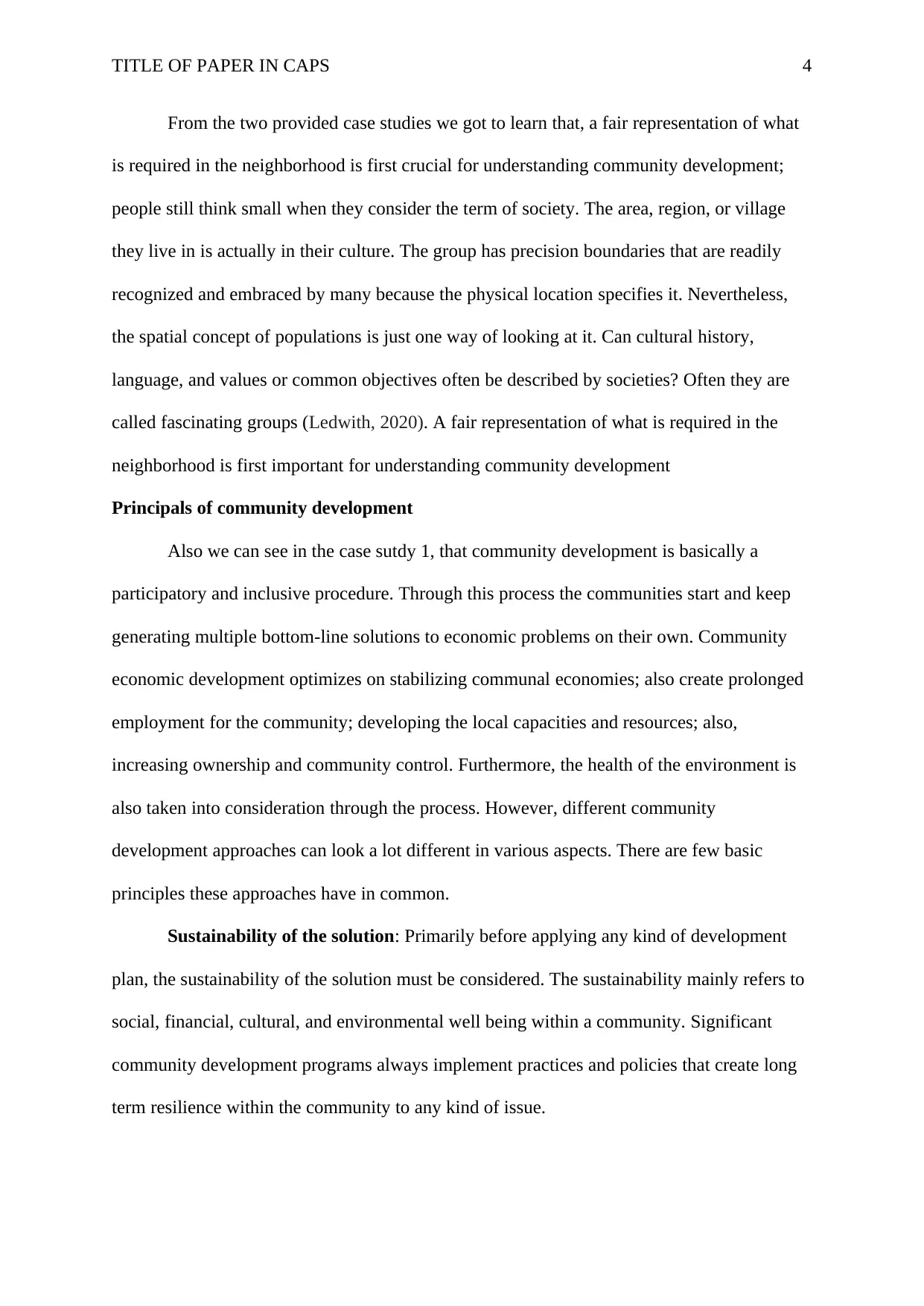
TITLE OF PAPER IN CAPS 4
From the two provided case studies we got to learn that, a fair representation of what
is required in the neighborhood is first crucial for understanding community development;
people still think small when they consider the term of society. The area, region, or village
they live in is actually in their culture. The group has precision boundaries that are readily
recognized and embraced by many because the physical location specifies it. Nevertheless,
the spatial concept of populations is just one way of looking at it. Can cultural history,
language, and values or common objectives often be described by societies? Often they are
called fascinating groups (Ledwith, 2020). A fair representation of what is required in the
neighborhood is first important for understanding community development
Principals of community development
Also we can see in the case sutdy 1, that community development is basically a
participatory and inclusive procedure. Through this process the communities start and keep
generating multiple bottom-line solutions to economic problems on their own. Community
economic development optimizes on stabilizing communal economies; also create prolonged
employment for the community; developing the local capacities and resources; also,
increasing ownership and community control. Furthermore, the health of the environment is
also taken into consideration through the process. However, different community
development approaches can look a lot different in various aspects. There are few basic
principles these approaches have in common.
Sustainability of the solution: Primarily before applying any kind of development
plan, the sustainability of the solution must be considered. The sustainability mainly refers to
social, financial, cultural, and environmental well being within a community. Significant
community development programs always implement practices and policies that create long
term resilience within the community to any kind of issue.
From the two provided case studies we got to learn that, a fair representation of what
is required in the neighborhood is first crucial for understanding community development;
people still think small when they consider the term of society. The area, region, or village
they live in is actually in their culture. The group has precision boundaries that are readily
recognized and embraced by many because the physical location specifies it. Nevertheless,
the spatial concept of populations is just one way of looking at it. Can cultural history,
language, and values or common objectives often be described by societies? Often they are
called fascinating groups (Ledwith, 2020). A fair representation of what is required in the
neighborhood is first important for understanding community development
Principals of community development
Also we can see in the case sutdy 1, that community development is basically a
participatory and inclusive procedure. Through this process the communities start and keep
generating multiple bottom-line solutions to economic problems on their own. Community
economic development optimizes on stabilizing communal economies; also create prolonged
employment for the community; developing the local capacities and resources; also,
increasing ownership and community control. Furthermore, the health of the environment is
also taken into consideration through the process. However, different community
development approaches can look a lot different in various aspects. There are few basic
principles these approaches have in common.
Sustainability of the solution: Primarily before applying any kind of development
plan, the sustainability of the solution must be considered. The sustainability mainly refers to
social, financial, cultural, and environmental well being within a community. Significant
community development programs always implement practices and policies that create long
term resilience within the community to any kind of issue.
Paraphrase This Document
Need a fresh take? Get an instant paraphrase of this document with our AI Paraphraser
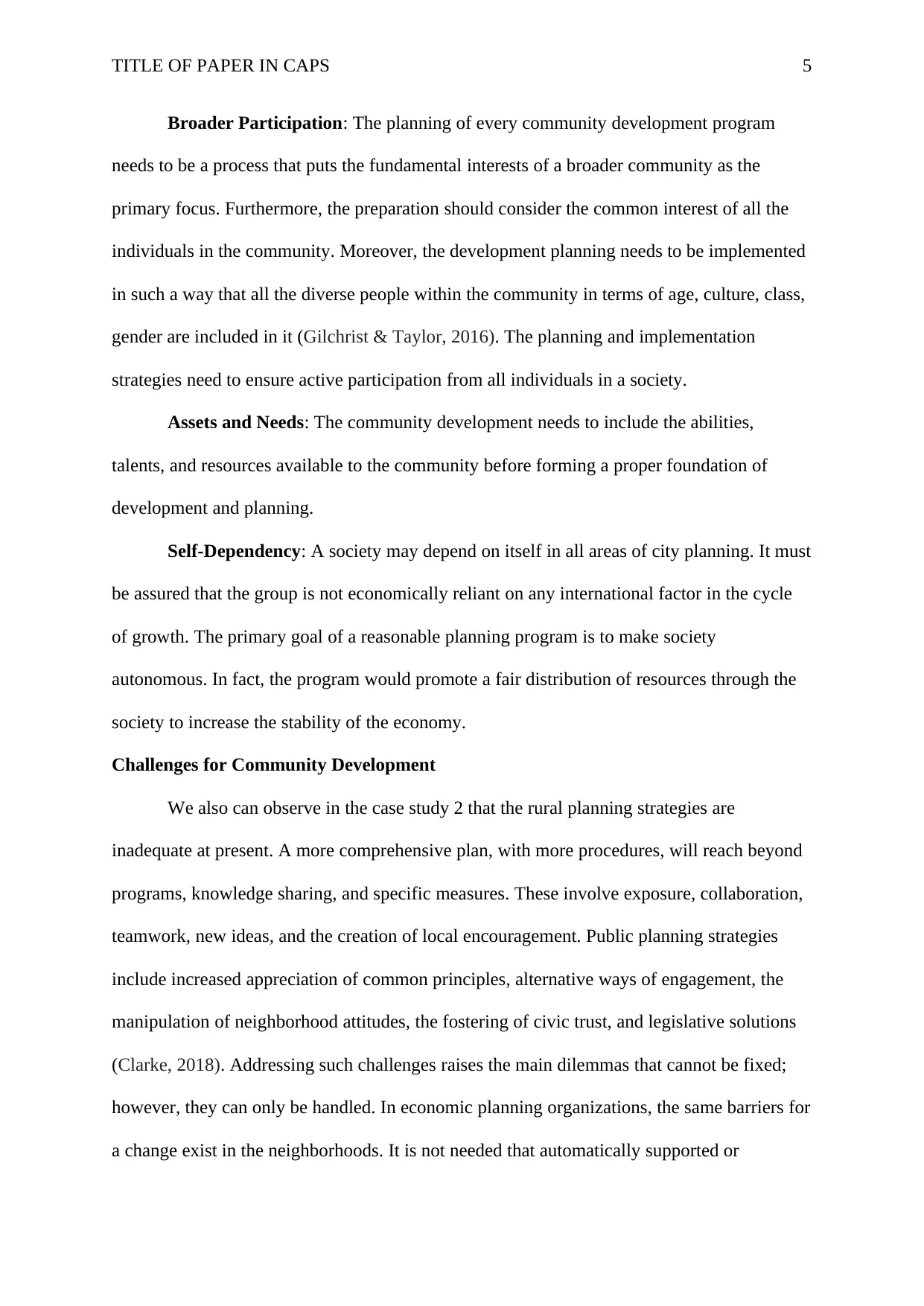
TITLE OF PAPER IN CAPS 5
Broader Participation: The planning of every community development program
needs to be a process that puts the fundamental interests of a broader community as the
primary focus. Furthermore, the preparation should consider the common interest of all the
individuals in the community. Moreover, the development planning needs to be implemented
in such a way that all the diverse people within the community in terms of age, culture, class,
gender are included in it (Gilchrist & Taylor, 2016). The planning and implementation
strategies need to ensure active participation from all individuals in a society.
Assets and Needs: The community development needs to include the abilities,
talents, and resources available to the community before forming a proper foundation of
development and planning.
Self-Dependency: A society may depend on itself in all areas of city planning. It must
be assured that the group is not economically reliant on any international factor in the cycle
of growth. The primary goal of a reasonable planning program is to make society
autonomous. In fact, the program would promote a fair distribution of resources through the
society to increase the stability of the economy.
Challenges for Community Development
We also can observe in the case study 2 that the rural planning strategies are
inadequate at present. A more comprehensive plan, with more procedures, will reach beyond
programs, knowledge sharing, and specific measures. These involve exposure, collaboration,
teamwork, new ideas, and the creation of local encouragement. Public planning strategies
include increased appreciation of common principles, alternative ways of engagement, the
manipulation of neighborhood attitudes, the fostering of civic trust, and legislative solutions
(Clarke, 2018). Addressing such challenges raises the main dilemmas that cannot be fixed;
however, they can only be handled. In economic planning organizations, the same barriers for
a change exist in the neighborhoods. It is not needed that automatically supported or
Broader Participation: The planning of every community development program
needs to be a process that puts the fundamental interests of a broader community as the
primary focus. Furthermore, the preparation should consider the common interest of all the
individuals in the community. Moreover, the development planning needs to be implemented
in such a way that all the diverse people within the community in terms of age, culture, class,
gender are included in it (Gilchrist & Taylor, 2016). The planning and implementation
strategies need to ensure active participation from all individuals in a society.
Assets and Needs: The community development needs to include the abilities,
talents, and resources available to the community before forming a proper foundation of
development and planning.
Self-Dependency: A society may depend on itself in all areas of city planning. It must
be assured that the group is not economically reliant on any international factor in the cycle
of growth. The primary goal of a reasonable planning program is to make society
autonomous. In fact, the program would promote a fair distribution of resources through the
society to increase the stability of the economy.
Challenges for Community Development
We also can observe in the case study 2 that the rural planning strategies are
inadequate at present. A more comprehensive plan, with more procedures, will reach beyond
programs, knowledge sharing, and specific measures. These involve exposure, collaboration,
teamwork, new ideas, and the creation of local encouragement. Public planning strategies
include increased appreciation of common principles, alternative ways of engagement, the
manipulation of neighborhood attitudes, the fostering of civic trust, and legislative solutions
(Clarke, 2018). Addressing such challenges raises the main dilemmas that cannot be fixed;
however, they can only be handled. In economic planning organizations, the same barriers for
a change exist in the neighborhoods. It is not needed that automatically supported or
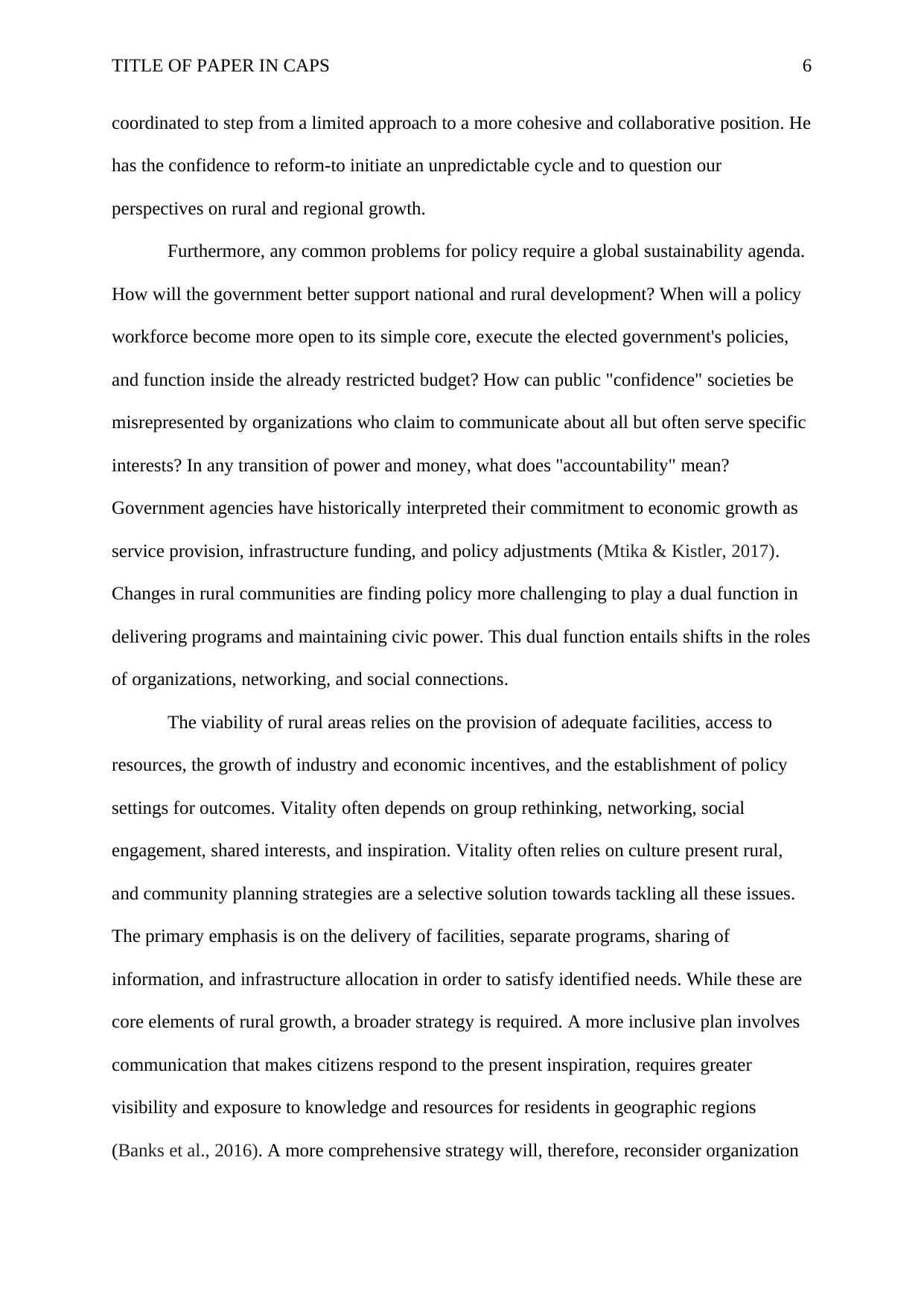
TITLE OF PAPER IN CAPS 6
coordinated to step from a limited approach to a more cohesive and collaborative position. He
has the confidence to reform-to initiate an unpredictable cycle and to question our
perspectives on rural and regional growth.
Furthermore, any common problems for policy require a global sustainability agenda.
How will the government better support national and rural development? When will a policy
workforce become more open to its simple core, execute the elected government's policies,
and function inside the already restricted budget? How can public "confidence" societies be
misrepresented by organizations who claim to communicate about all but often serve specific
interests? In any transition of power and money, what does "accountability" mean?
Government agencies have historically interpreted their commitment to economic growth as
service provision, infrastructure funding, and policy adjustments (Mtika & Kistler, 2017).
Changes in rural communities are finding policy more challenging to play a dual function in
delivering programs and maintaining civic power. This dual function entails shifts in the roles
of organizations, networking, and social connections.
The viability of rural areas relies on the provision of adequate facilities, access to
resources, the growth of industry and economic incentives, and the establishment of policy
settings for outcomes. Vitality often depends on group rethinking, networking, social
engagement, shared interests, and inspiration. Vitality often relies on culture present rural,
and community planning strategies are a selective solution towards tackling all these issues.
The primary emphasis is on the delivery of facilities, separate programs, sharing of
information, and infrastructure allocation in order to satisfy identified needs. While these are
core elements of rural growth, a broader strategy is required. A more inclusive plan involves
communication that makes citizens respond to the present inspiration, requires greater
visibility and exposure to knowledge and resources for residents in geographic regions
(Banks et al., 2016). A more comprehensive strategy will, therefore, reconsider organization
coordinated to step from a limited approach to a more cohesive and collaborative position. He
has the confidence to reform-to initiate an unpredictable cycle and to question our
perspectives on rural and regional growth.
Furthermore, any common problems for policy require a global sustainability agenda.
How will the government better support national and rural development? When will a policy
workforce become more open to its simple core, execute the elected government's policies,
and function inside the already restricted budget? How can public "confidence" societies be
misrepresented by organizations who claim to communicate about all but often serve specific
interests? In any transition of power and money, what does "accountability" mean?
Government agencies have historically interpreted their commitment to economic growth as
service provision, infrastructure funding, and policy adjustments (Mtika & Kistler, 2017).
Changes in rural communities are finding policy more challenging to play a dual function in
delivering programs and maintaining civic power. This dual function entails shifts in the roles
of organizations, networking, and social connections.
The viability of rural areas relies on the provision of adequate facilities, access to
resources, the growth of industry and economic incentives, and the establishment of policy
settings for outcomes. Vitality often depends on group rethinking, networking, social
engagement, shared interests, and inspiration. Vitality often relies on culture present rural,
and community planning strategies are a selective solution towards tackling all these issues.
The primary emphasis is on the delivery of facilities, separate programs, sharing of
information, and infrastructure allocation in order to satisfy identified needs. While these are
core elements of rural growth, a broader strategy is required. A more inclusive plan involves
communication that makes citizens respond to the present inspiration, requires greater
visibility and exposure to knowledge and resources for residents in geographic regions
(Banks et al., 2016). A more comprehensive strategy will, therefore, reconsider organization
⊘ This is a preview!⊘
Do you want full access?
Subscribe today to unlock all pages.

Trusted by 1+ million students worldwide
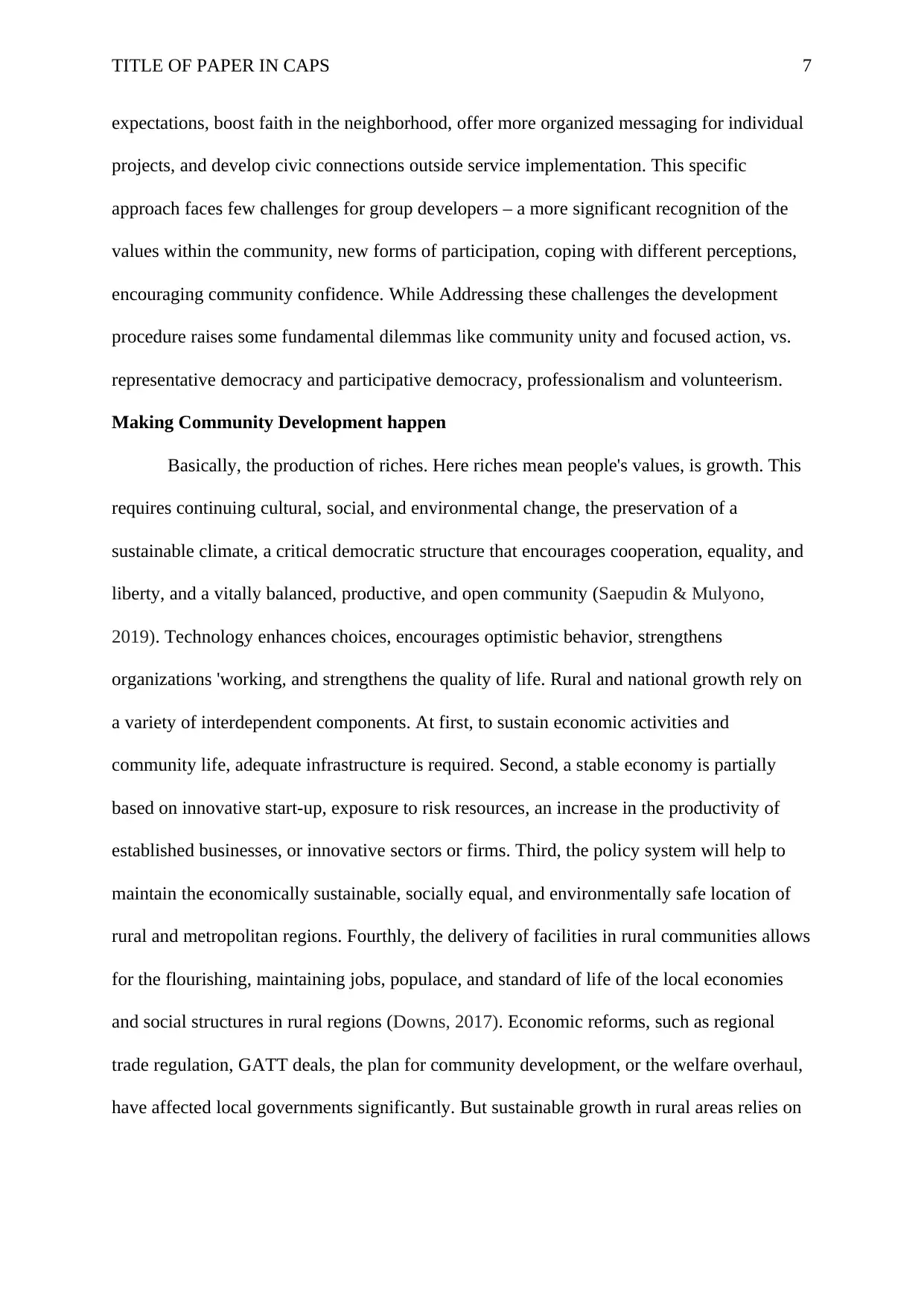
TITLE OF PAPER IN CAPS 7
expectations, boost faith in the neighborhood, offer more organized messaging for individual
projects, and develop civic connections outside service implementation. This specific
approach faces few challenges for group developers – a more significant recognition of the
values within the community, new forms of participation, coping with different perceptions,
encouraging community confidence. While Addressing these challenges the development
procedure raises some fundamental dilemmas like community unity and focused action, vs.
representative democracy and participative democracy, professionalism and volunteerism.
Making Community Development happen
Basically, the production of riches. Here riches mean people's values, is growth. This
requires continuing cultural, social, and environmental change, the preservation of a
sustainable climate, a critical democratic structure that encourages cooperation, equality, and
liberty, and a vitally balanced, productive, and open community (Saepudin & Mulyono,
2019). Technology enhances choices, encourages optimistic behavior, strengthens
organizations 'working, and strengthens the quality of life. Rural and national growth rely on
a variety of interdependent components. At first, to sustain economic activities and
community life, adequate infrastructure is required. Second, a stable economy is partially
based on innovative start-up, exposure to risk resources, an increase in the productivity of
established businesses, or innovative sectors or firms. Third, the policy system will help to
maintain the economically sustainable, socially equal, and environmentally safe location of
rural and metropolitan regions. Fourthly, the delivery of facilities in rural communities allows
for the flourishing, maintaining jobs, populace, and standard of life of the local economies
and social structures in rural regions (Downs, 2017). Economic reforms, such as regional
trade regulation, GATT deals, the plan for community development, or the welfare overhaul,
have affected local governments significantly. But sustainable growth in rural areas relies on
expectations, boost faith in the neighborhood, offer more organized messaging for individual
projects, and develop civic connections outside service implementation. This specific
approach faces few challenges for group developers – a more significant recognition of the
values within the community, new forms of participation, coping with different perceptions,
encouraging community confidence. While Addressing these challenges the development
procedure raises some fundamental dilemmas like community unity and focused action, vs.
representative democracy and participative democracy, professionalism and volunteerism.
Making Community Development happen
Basically, the production of riches. Here riches mean people's values, is growth. This
requires continuing cultural, social, and environmental change, the preservation of a
sustainable climate, a critical democratic structure that encourages cooperation, equality, and
liberty, and a vitally balanced, productive, and open community (Saepudin & Mulyono,
2019). Technology enhances choices, encourages optimistic behavior, strengthens
organizations 'working, and strengthens the quality of life. Rural and national growth rely on
a variety of interdependent components. At first, to sustain economic activities and
community life, adequate infrastructure is required. Second, a stable economy is partially
based on innovative start-up, exposure to risk resources, an increase in the productivity of
established businesses, or innovative sectors or firms. Third, the policy system will help to
maintain the economically sustainable, socially equal, and environmentally safe location of
rural and metropolitan regions. Fourthly, the delivery of facilities in rural communities allows
for the flourishing, maintaining jobs, populace, and standard of life of the local economies
and social structures in rural regions (Downs, 2017). Economic reforms, such as regional
trade regulation, GATT deals, the plan for community development, or the welfare overhaul,
have affected local governments significantly. But sustainable growth in rural areas relies on
Paraphrase This Document
Need a fresh take? Get an instant paraphrase of this document with our AI Paraphraser
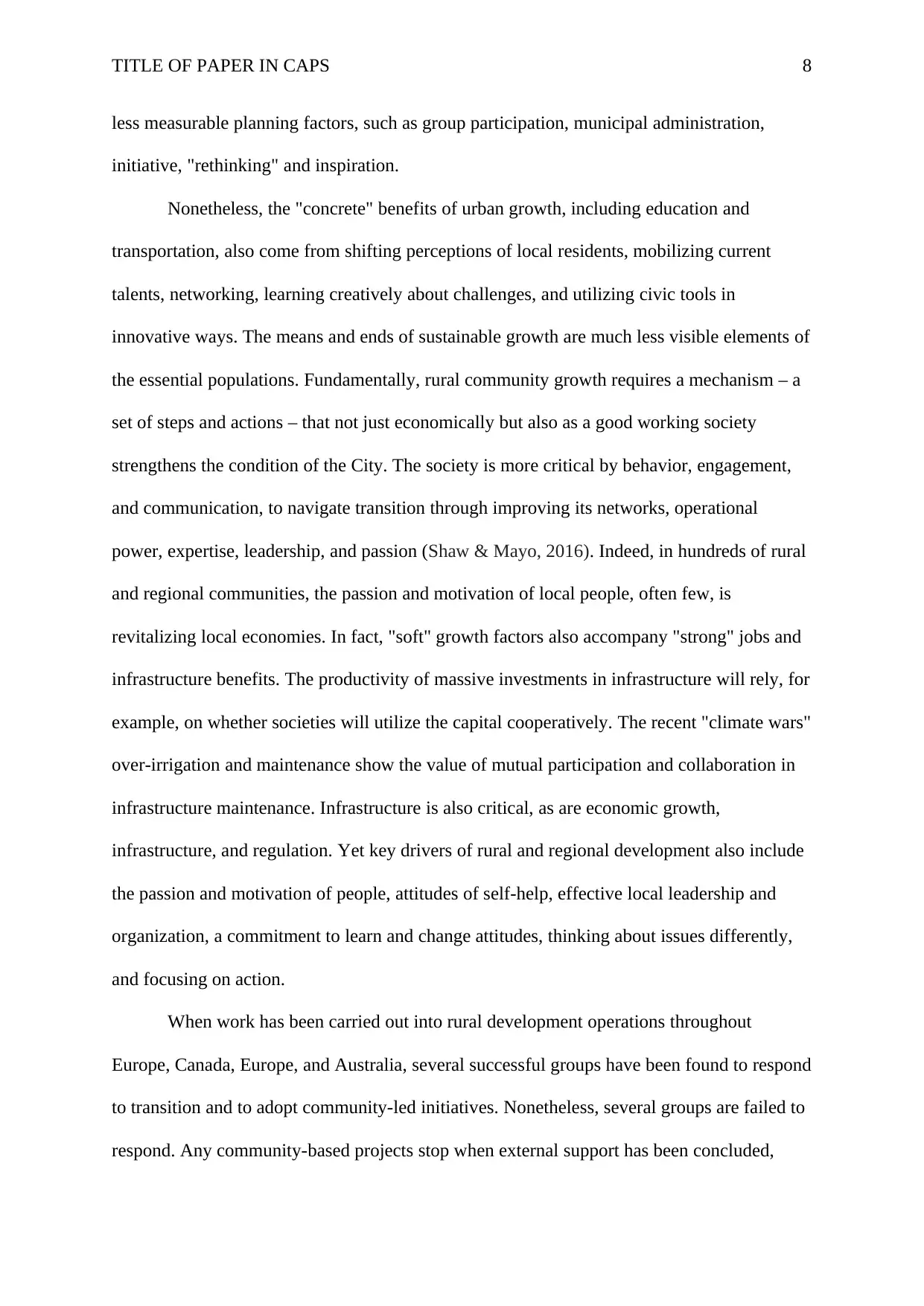
TITLE OF PAPER IN CAPS 8
less measurable planning factors, such as group participation, municipal administration,
initiative, "rethinking" and inspiration.
Nonetheless, the "concrete" benefits of urban growth, including education and
transportation, also come from shifting perceptions of local residents, mobilizing current
talents, networking, learning creatively about challenges, and utilizing civic tools in
innovative ways. The means and ends of sustainable growth are much less visible elements of
the essential populations. Fundamentally, rural community growth requires a mechanism – a
set of steps and actions – that not just economically but also as a good working society
strengthens the condition of the City. The society is more critical by behavior, engagement,
and communication, to navigate transition through improving its networks, operational
power, expertise, leadership, and passion (Shaw & Mayo, 2016). Indeed, in hundreds of rural
and regional communities, the passion and motivation of local people, often few, is
revitalizing local economies. In fact, "soft" growth factors also accompany "strong" jobs and
infrastructure benefits. The productivity of massive investments in infrastructure will rely, for
example, on whether societies will utilize the capital cooperatively. The recent "climate wars"
over-irrigation and maintenance show the value of mutual participation and collaboration in
infrastructure maintenance. Infrastructure is also critical, as are economic growth,
infrastructure, and regulation. Yet key drivers of rural and regional development also include
the passion and motivation of people, attitudes of self-help, effective local leadership and
organization, a commitment to learn and change attitudes, thinking about issues differently,
and focusing on action.
When work has been carried out into rural development operations throughout
Europe, Canada, Europe, and Australia, several successful groups have been found to respond
to transition and to adopt community-led initiatives. Nonetheless, several groups are failed to
respond. Any community-based projects stop when external support has been concluded,
less measurable planning factors, such as group participation, municipal administration,
initiative, "rethinking" and inspiration.
Nonetheless, the "concrete" benefits of urban growth, including education and
transportation, also come from shifting perceptions of local residents, mobilizing current
talents, networking, learning creatively about challenges, and utilizing civic tools in
innovative ways. The means and ends of sustainable growth are much less visible elements of
the essential populations. Fundamentally, rural community growth requires a mechanism – a
set of steps and actions – that not just economically but also as a good working society
strengthens the condition of the City. The society is more critical by behavior, engagement,
and communication, to navigate transition through improving its networks, operational
power, expertise, leadership, and passion (Shaw & Mayo, 2016). Indeed, in hundreds of rural
and regional communities, the passion and motivation of local people, often few, is
revitalizing local economies. In fact, "soft" growth factors also accompany "strong" jobs and
infrastructure benefits. The productivity of massive investments in infrastructure will rely, for
example, on whether societies will utilize the capital cooperatively. The recent "climate wars"
over-irrigation and maintenance show the value of mutual participation and collaboration in
infrastructure maintenance. Infrastructure is also critical, as are economic growth,
infrastructure, and regulation. Yet key drivers of rural and regional development also include
the passion and motivation of people, attitudes of self-help, effective local leadership and
organization, a commitment to learn and change attitudes, thinking about issues differently,
and focusing on action.
When work has been carried out into rural development operations throughout
Europe, Canada, Europe, and Australia, several successful groups have been found to respond
to transition and to adopt community-led initiatives. Nonetheless, several groups are failed to
respond. Any community-based projects stop when external support has been concluded,
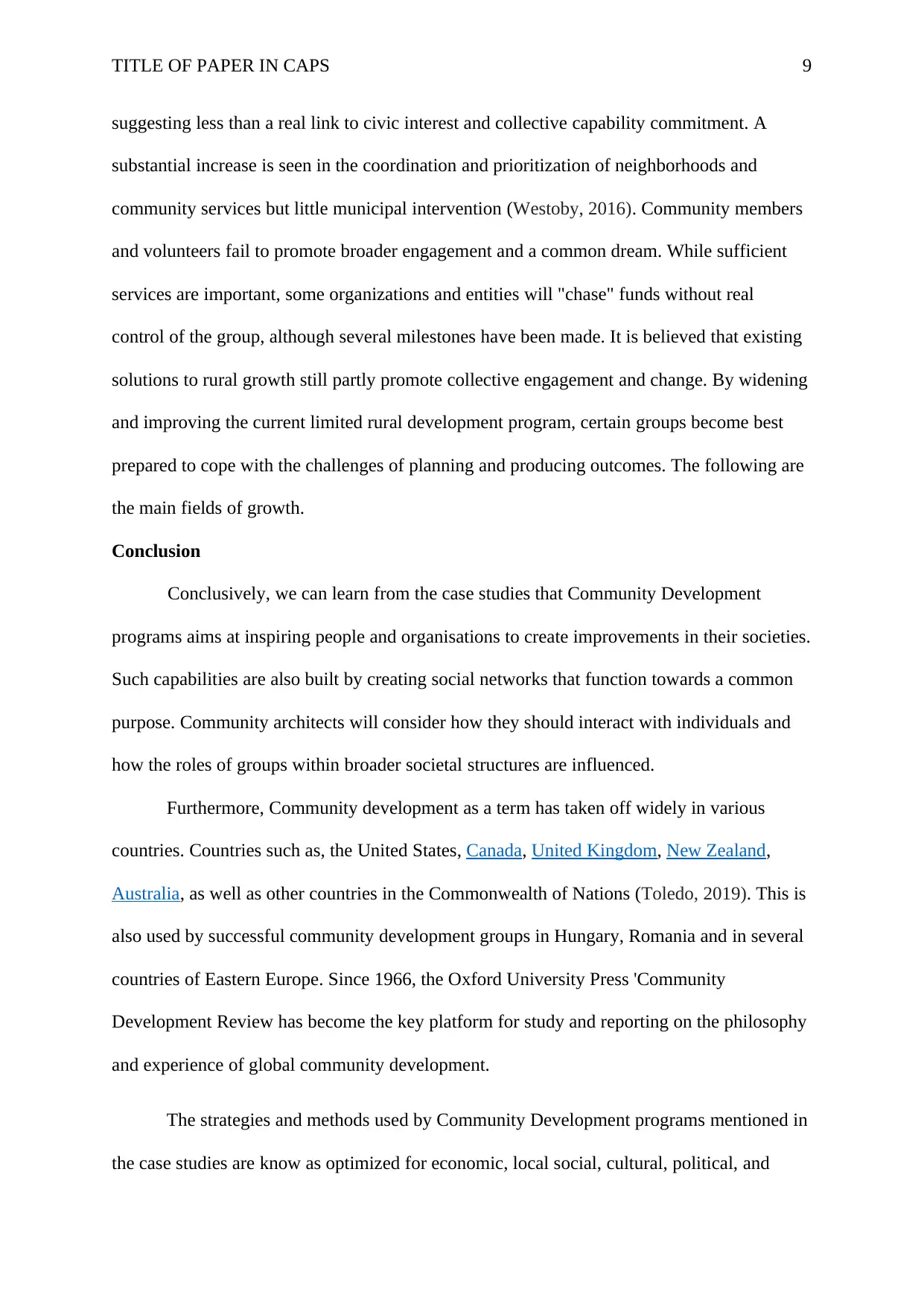
TITLE OF PAPER IN CAPS 9
suggesting less than a real link to civic interest and collective capability commitment. A
substantial increase is seen in the coordination and prioritization of neighborhoods and
community services but little municipal intervention (Westoby, 2016). Community members
and volunteers fail to promote broader engagement and a common dream. While sufficient
services are important, some organizations and entities will "chase" funds without real
control of the group, although several milestones have been made. It is believed that existing
solutions to rural growth still partly promote collective engagement and change. By widening
and improving the current limited rural development program, certain groups become best
prepared to cope with the challenges of planning and producing outcomes. The following are
the main fields of growth.
Conclusion
Conclusively, we can learn from the case studies that Community Development
programs aims at inspiring people and organisations to create improvements in their societies.
Such capabilities are also built by creating social networks that function towards a common
purpose. Community architects will consider how they should interact with individuals and
how the roles of groups within broader societal structures are influenced.
Furthermore, Community development as a term has taken off widely in various
countries. Countries such as, the United States, Canada, United Kingdom, New Zealand,
Australia, as well as other countries in the Commonwealth of Nations (Toledo, 2019). This is
also used by successful community development groups in Hungary, Romania and in several
countries of Eastern Europe. Since 1966, the Oxford University Press 'Community
Development Review has become the key platform for study and reporting on the philosophy
and experience of global community development.
The strategies and methods used by Community Development programs mentioned in
the case studies are know as optimized for economic, local social, cultural, political, and
suggesting less than a real link to civic interest and collective capability commitment. A
substantial increase is seen in the coordination and prioritization of neighborhoods and
community services but little municipal intervention (Westoby, 2016). Community members
and volunteers fail to promote broader engagement and a common dream. While sufficient
services are important, some organizations and entities will "chase" funds without real
control of the group, although several milestones have been made. It is believed that existing
solutions to rural growth still partly promote collective engagement and change. By widening
and improving the current limited rural development program, certain groups become best
prepared to cope with the challenges of planning and producing outcomes. The following are
the main fields of growth.
Conclusion
Conclusively, we can learn from the case studies that Community Development
programs aims at inspiring people and organisations to create improvements in their societies.
Such capabilities are also built by creating social networks that function towards a common
purpose. Community architects will consider how they should interact with individuals and
how the roles of groups within broader societal structures are influenced.
Furthermore, Community development as a term has taken off widely in various
countries. Countries such as, the United States, Canada, United Kingdom, New Zealand,
Australia, as well as other countries in the Commonwealth of Nations (Toledo, 2019). This is
also used by successful community development groups in Hungary, Romania and in several
countries of Eastern Europe. Since 1966, the Oxford University Press 'Community
Development Review has become the key platform for study and reporting on the philosophy
and experience of global community development.
The strategies and methods used by Community Development programs mentioned in
the case studies are know as optimized for economic, local social, cultural, political, and
⊘ This is a preview!⊘
Do you want full access?
Subscribe today to unlock all pages.

Trusted by 1+ million students worldwide

TITLE OF PAPER IN CAPS 10
environmental development by profitable and non-profitable organizations like the WHO
UN, OECD, Council of Europe and the World Bank (Roseland & Spiliotopoulou, 2017).
Community development is a process where community members come together to take
collective action and generate solutions to common problems. Community wellbeing
throughout environmental, economic, cultural, and social aspects of the community often
developed from such collective action being considered at a grassroots level.
environmental development by profitable and non-profitable organizations like the WHO
UN, OECD, Council of Europe and the World Bank (Roseland & Spiliotopoulou, 2017).
Community development is a process where community members come together to take
collective action and generate solutions to common problems. Community wellbeing
throughout environmental, economic, cultural, and social aspects of the community often
developed from such collective action being considered at a grassroots level.
Paraphrase This Document
Need a fresh take? Get an instant paraphrase of this document with our AI Paraphraser
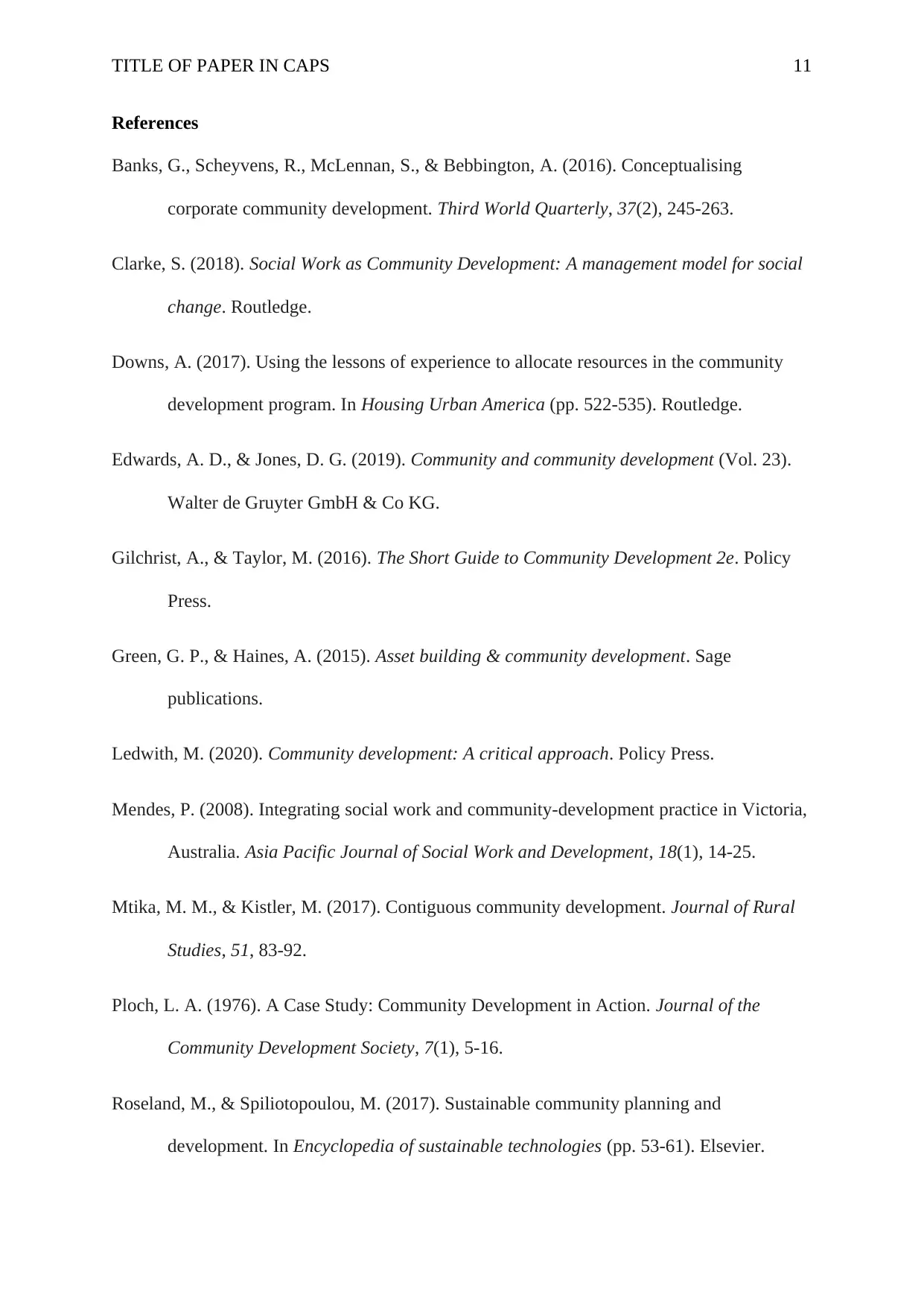
TITLE OF PAPER IN CAPS 11
References
Banks, G., Scheyvens, R., McLennan, S., & Bebbington, A. (2016). Conceptualising
corporate community development. Third World Quarterly, 37(2), 245-263.
Clarke, S. (2018). Social Work as Community Development: A management model for social
change. Routledge.
Downs, A. (2017). Using the lessons of experience to allocate resources in the community
development program. In Housing Urban America (pp. 522-535). Routledge.
Edwards, A. D., & Jones, D. G. (2019). Community and community development (Vol. 23).
Walter de Gruyter GmbH & Co KG.
Gilchrist, A., & Taylor, M. (2016). The Short Guide to Community Development 2e. Policy
Press.
Green, G. P., & Haines, A. (2015). Asset building & community development. Sage
publications.
Ledwith, M. (2020). Community development: A critical approach. Policy Press.
Mendes, P. (2008). Integrating social work and community-development practice in Victoria,
Australia. Asia Pacific Journal of Social Work and Development, 18(1), 14-25.
Mtika, M. M., & Kistler, M. (2017). Contiguous community development. Journal of Rural
Studies, 51, 83-92.
Ploch, L. A. (1976). A Case Study: Community Development in Action. Journal of the
Community Development Society, 7(1), 5-16.
Roseland, M., & Spiliotopoulou, M. (2017). Sustainable community planning and
development. In Encyclopedia of sustainable technologies (pp. 53-61). Elsevier.
References
Banks, G., Scheyvens, R., McLennan, S., & Bebbington, A. (2016). Conceptualising
corporate community development. Third World Quarterly, 37(2), 245-263.
Clarke, S. (2018). Social Work as Community Development: A management model for social
change. Routledge.
Downs, A. (2017). Using the lessons of experience to allocate resources in the community
development program. In Housing Urban America (pp. 522-535). Routledge.
Edwards, A. D., & Jones, D. G. (2019). Community and community development (Vol. 23).
Walter de Gruyter GmbH & Co KG.
Gilchrist, A., & Taylor, M. (2016). The Short Guide to Community Development 2e. Policy
Press.
Green, G. P., & Haines, A. (2015). Asset building & community development. Sage
publications.
Ledwith, M. (2020). Community development: A critical approach. Policy Press.
Mendes, P. (2008). Integrating social work and community-development practice in Victoria,
Australia. Asia Pacific Journal of Social Work and Development, 18(1), 14-25.
Mtika, M. M., & Kistler, M. (2017). Contiguous community development. Journal of Rural
Studies, 51, 83-92.
Ploch, L. A. (1976). A Case Study: Community Development in Action. Journal of the
Community Development Society, 7(1), 5-16.
Roseland, M., & Spiliotopoulou, M. (2017). Sustainable community planning and
development. In Encyclopedia of sustainable technologies (pp. 53-61). Elsevier.
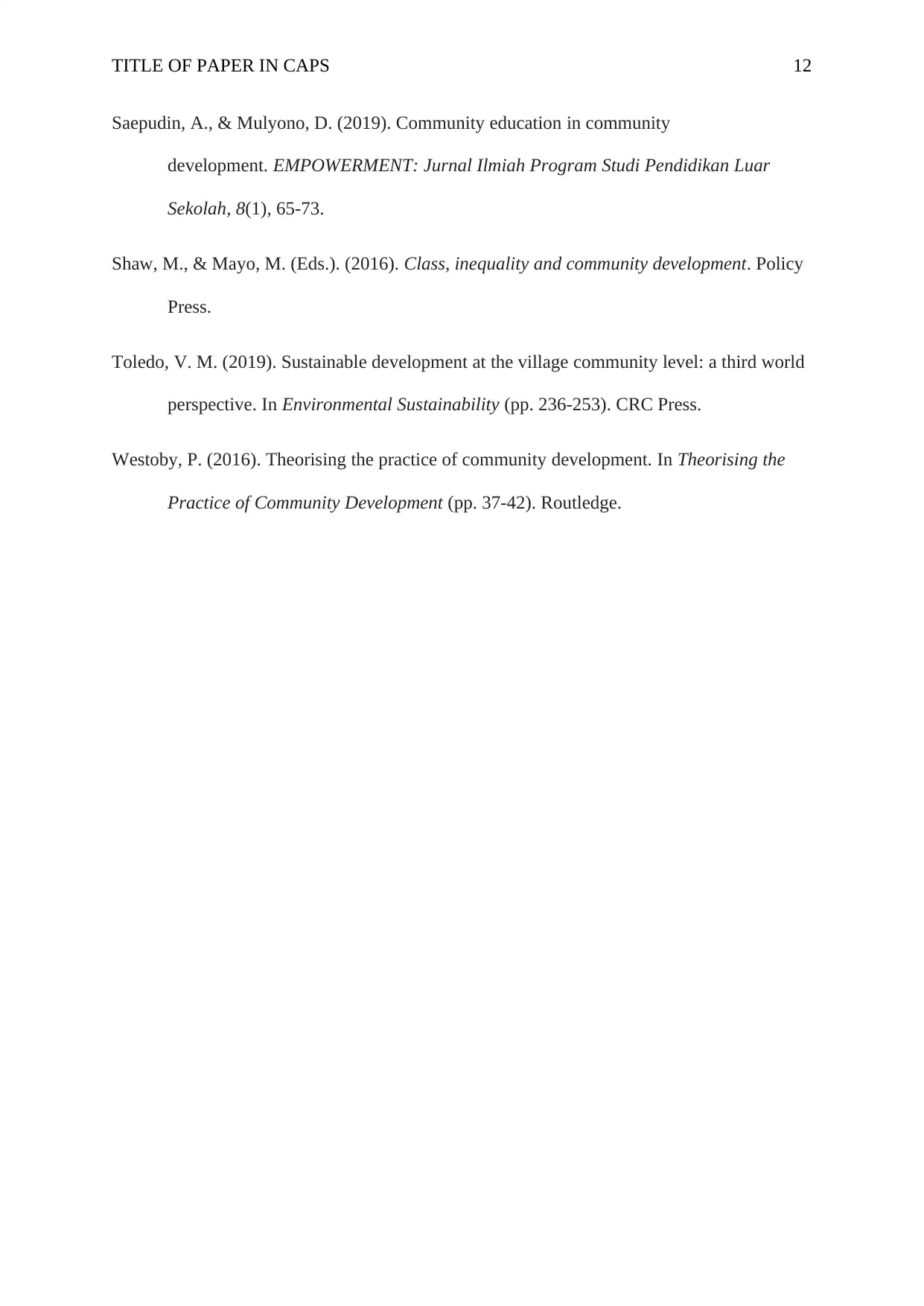
TITLE OF PAPER IN CAPS 12
Saepudin, A., & Mulyono, D. (2019). Community education in community
development. EMPOWERMENT: Jurnal Ilmiah Program Studi Pendidikan Luar
Sekolah, 8(1), 65-73.
Shaw, M., & Mayo, M. (Eds.). (2016). Class, inequality and community development. Policy
Press.
Toledo, V. M. (2019). Sustainable development at the village community level: a third world
perspective. In Environmental Sustainability (pp. 236-253). CRC Press.
Westoby, P. (2016). Theorising the practice of community development. In Theorising the
Practice of Community Development (pp. 37-42). Routledge.
Saepudin, A., & Mulyono, D. (2019). Community education in community
development. EMPOWERMENT: Jurnal Ilmiah Program Studi Pendidikan Luar
Sekolah, 8(1), 65-73.
Shaw, M., & Mayo, M. (Eds.). (2016). Class, inequality and community development. Policy
Press.
Toledo, V. M. (2019). Sustainable development at the village community level: a third world
perspective. In Environmental Sustainability (pp. 236-253). CRC Press.
Westoby, P. (2016). Theorising the practice of community development. In Theorising the
Practice of Community Development (pp. 37-42). Routledge.
⊘ This is a preview!⊘
Do you want full access?
Subscribe today to unlock all pages.

Trusted by 1+ million students worldwide
1 out of 12
Related Documents
Your All-in-One AI-Powered Toolkit for Academic Success.
+13062052269
info@desklib.com
Available 24*7 on WhatsApp / Email
![[object Object]](/_next/static/media/star-bottom.7253800d.svg)
Unlock your academic potential
Copyright © 2020–2025 A2Z Services. All Rights Reserved. Developed and managed by ZUCOL.





